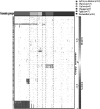Clinical value of chromosome arms 19q and 11p losses in low-grade gliomas
- PMID: 24335697
- PMCID: PMC3922518
- DOI: 10.1093/neuonc/not227
Clinical value of chromosome arms 19q and 11p losses in low-grade gliomas
Abstract
Background: Diffuse low-grade gliomas (LGGs) form a heterogeneous subgroup of gliomas in adults. Chromosome (chr) arms 1p/19q codeletion and IDH mutation have been shown to be closely associated with oligodendroglial phenotype and better prognosis. We sought to identify relevant biomarkers in non 1p/19q codeleted LGGs.
Methods: We characterized a retrospective series of 126 LGGs using genomic arrays, microsatellite analysis, IDH sequencing, MGMT promoter methylation assay, and p53 expression analysis.
Results: Our study confirms that 1p/19q codeletion, mutually exclusive with p53 overexpression, was associated with: (i) better prognosis, (ii) oligodendroglial phenotype, (iii) MGMT promoter methylation, and (iv) IDH mutation. Interestingly, 1p/19q codeleted tumors occur in older patients at diagnosis. Our study shows that non 1p/19q codeleted LGGs can be divided in 5 main genomic subgroups: (i) 11p loss, (ii) 19q loss (iii) 7 gain, (iv) 19 gain, and (v) unclassified. In non 1p/19q codeleted LGGs, we demonstrated that (i) 11p loss is associated with astrocytoma phenotype and has an independent negative prognostic value, and (ii) 19q loss diminished the favorable prognostic value of IDH mutation. Our findings were validated in an independent cohort of 98 LGGs.
Conclusion: Novel genomic entities and biomarkers have been identified in non 1p/19q codeleted LGGs. Our findings may help to stratify non 1p/19q codeleted LGGs, facilitating future individualization of treatment. Further prospective studies are warranted to support our findings.
Keywords: IDH; MGMT, TP53; biomarker; genomic array; low-grade gliomas.
Figures




References
-
- Smith JS, Perry A, Borell TJ, et al. Alterations of chromosome arms 1p and 19q as predictors of survival in oligodendrogliomas, astrocytomas, and mixed oligoastrocytomas. J Clin Oncol. 2000;18(3):636–645. - PubMed
-
- Louis D, Ohgaki H, Wiestler O, Cavenee W. WHO Classification of Tumors of the Central Nervous System. 4th ed. Ogdensburg: Renouf Publishing Co. Ltd; 2007.
-
- Ohgaki H, Kleihues P. Population-based studies on incidence, survival rates, and genetic alterations in astrocytic and oligodendroglial gliomas. J Neuropathol Exp Neurol. 2005;64(6):479–489. - PubMed
-
- Coons SW, Johnson PC, Scheithauer BW, et al. Improving diagnostic accuracy and interobserver concordance in the classification and grading of primary gliomas. Cancer. 1997;79(7):1381–1393. - PubMed
-
- Bourne TD, Schiff D. Update on molecular findings, management and outcome in low-grade gliomas. Nat Rev Neurol. 2010;6(12):695–701. - PubMed
Publication types
MeSH terms
LinkOut - more resources
Full Text Sources
Other Literature Sources
Medical
Research Materials
Miscellaneous

